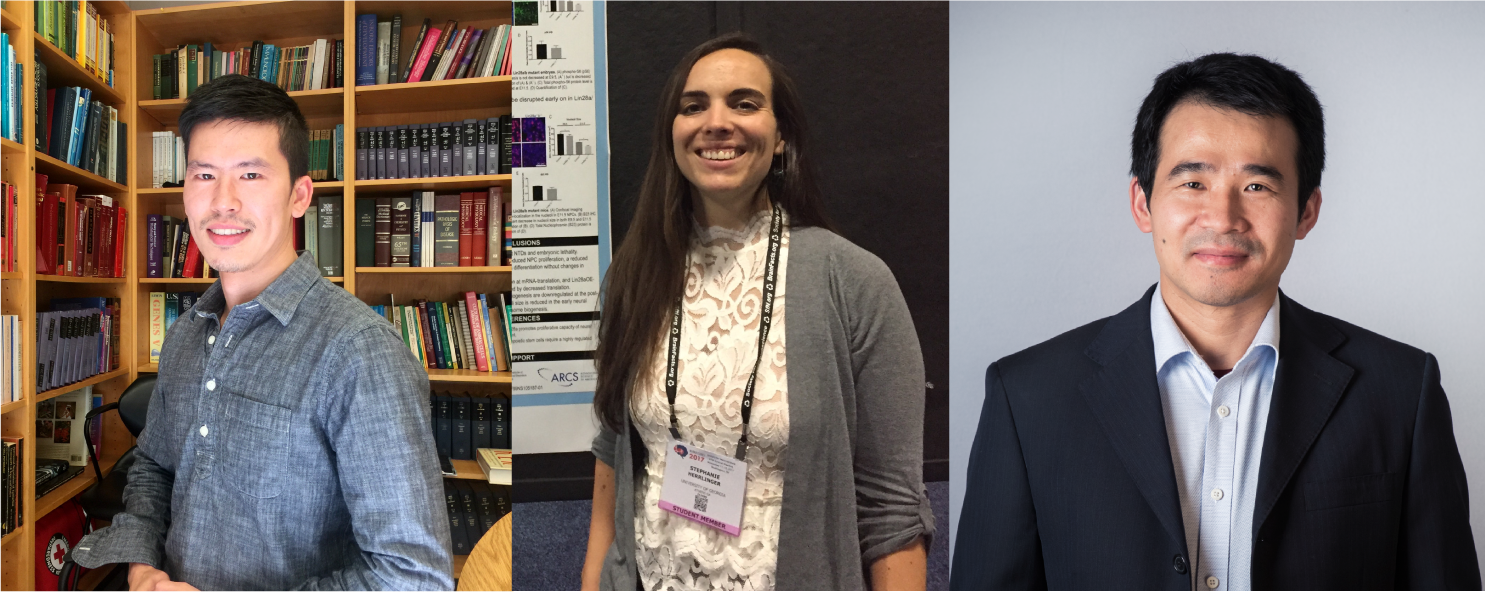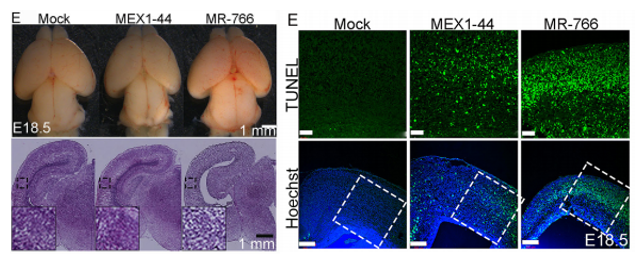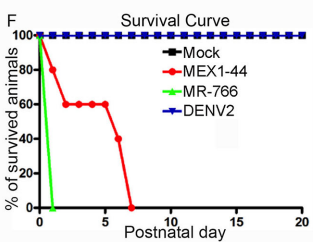The people behind the papers – Qiang Shao, Stephanie Herrlinger & Jian-Fu (Jeff) Chen
Posted by the Node Interviews, on 16 November 2017
Zika infection in humans is associated with birth defects including microcephaly. Zika has two major lineages – the Asian lineage, which has been associated with birth defects, and the African lineage, which has not – but the relative effects of each strain on brain development, and the effects of the related dengue virus that co-circulates with Zika, are not understood. This week we feature a paper published in the latest issue of Development that uses a mouse model to compare the individual effects of these viruses. Co-first authors, Qiang Shao and Stephanie Herrlinger, and PI Jian-Fu (Jeff) Chen told us more.

Jeff, can you give us your scientific biography and the main questions your lab is trying to answer?
JFC My lab is interested in mechanisms underlying microcephaly and neurodegeneration. We use mouse and human pluripotent stem cell-derived neural cells to model neurological disorders followed by mechanistic studies at molecular, cellular, and circuit levels.
Qiang and Stephanie, how did you come to join the Chen lab?
SH I have always been very passionate about studying the brain and I was looking for a mentor who was as enthusiastic as I was. Jeff’s previous work studying brain development and neural tube defects gave me the opportunity to explore brain development and embryology, and his enthusiasm for understanding biology is infectious. After the first week of my rotation with his lab, it was obvious that I was going to do my PhD with Jeff.
QS I did my PhD in China, focusing on the discovery of antiviral genes and drugs. I am always passionate about brain development and neuro-infectious disease. Before my graduation, one of my committee members, Dr. He, recommended me to Jeff for a postdoc position, knowing that he is an expert in neurodevelopmental disorders. After a few rounds of interviews, Jeff offered me this position. And here I am studying Zika virus and microcephaly.
What was known about the differences between the two lineages, both in the lab and in the human population, before your work?
JFC We knew that Asia Zika virus (ZIKV) is sufficient to cause microcephaly and additional brain abnormalities from both animal models and the human population. On the other hand, Africa ZIKV had not yet been associated with any birth or brain defects. Before our work, we also knew there was about a 110 amino acid difference between the Africa ZIKV isolate and Asia isolate in our lab, but we had no idea about their comparative toxicity and their impact to the developing brain.
Can you give is the key results of the paper in a paragraph?
JFC The key findings are that Africa Zika virus (ZIKV) grows faster, causes more cell death in neural progenitor cells (NPCs) and neurons, and leads to more severe brain damage and postnatal death than Asia ZIKV. Both viruses similarly infect NPCs and trigger microglial activation and astrogliosis. Meanwhile, Dengue virus also infects NPCs and grows robustly in the developing brain, but fails to cause brain damage and postnatal death. Therefore, Africa ZIKV and Asia ZIKV have some intrinsic differences that account for their differential impacts on the developing brain.

Why did you test this hypothesis in a mouse model as opposed to using human cerebral organoids?
JFC We previously have established the first postnatal microcephaly mouse model associated with ZIKV infection (Shao et al., Development, 2016). It is handy for us to use this system. It is absolutely important to further test this hypothesis using human cerebral organoids, which have the advantage of modelling early human brain development.
SH Cerebral organoids are a great system to study NPCs and NPC behaviours at early stages; however, the developing brain includes a diverse set of neural progenitor, immune, vascular, and glial cell types. With our mouse model, we are able to specifically ask how the heterogeneous cell populations of the brain responds and contributes to ZIKV infection pathology and disease progression.

You mention cases of co-infection between Zika and dengue, do you have plans to model this in mice and what effect do you hypothesise it will have on neural development?
JFC We would like to model it and we expect that co-infection between Zika and dengue will yield an intermediate brain defect.
What do you hypothesise the genetic/molecular basis might be for the different in virulence between the strains?
JFC We expect that certain mutations in one or more structural/non-structural viral proteins accounts for the difference. We are actively pursuing this direction now.
When doing the research, did you have any particular result or eureka moment that has stuck with you?
SH When we first saw the much more dramatic pathology of the African ZIKV strain on the developing brain, we were very surprised! The fact that this virus was not previously associated with birth defects was a big part of why we hypothesized that the Asian-ZIKV would be more deleterious than the African-ZIKV strain.
QS It was how the ZIKV African strain caused embryonic lethality that struck me the most. Before this study, there was no evidence suggesting an association between ZIKV African strain and microcephaly. I was expecting to see a mild phenotype in ZIKV African strain infected mouse embryos compared to Asian strain. It turned out that none of the ZIKV African strain infected embryo survived to postnatal stage. I was shocked by the phenotype of embryonic lethality. After this project, I realised unexpected results often lead to interesting and important discovery.

And what about the flipside: any moments of frustration or despair?
SH It was frustrating at first to find that the African-ZIKV infected embryos did not survive gestation as the Asian-ZIKV infected embryos did. We were initially concerned that it was due to some complication of the surgeries as they can be arduous and the embryos are sensitive.
QS ZIKV African and Asian strain side by side comparison surgery is the most difficult part of this study. Statistical analysis requires three biological replicates. So I had to inject three embryos with mock, ZIKV-African, and ZIKV-Asian, respectively, which means nine embryos in one litter. This presents with many technical and experimental challenges including the potential of early embryo loss. It took me a whole month to optimize surgical conditions such as polishing glass needles, reducing viral titer and adjusting injection sites. Fortunately, through a long process of trial and error, I was able to obtain enough samples to work with.

What are your career plans following this work?
SH I successfully received a predoctoral to postdoctoral transition award from the NIH (D-SPAN F99/K00) to study the impact that ZIKV has on post-transcriptional regulation in infected neural progenitor cells. In the coming year I plan to graduate and move on to my postdoctoral career.
QS I am currently writing a research proposal to further study the mechanism underlying ZIKV caused neurovascular defect. Specifically, I am interested in understanding the role of individual ZIKV protein in neurovascular development disruption. This work will provide important molecular mechanism of ZIKV pathogenesis.
And what next for the Chen lab?
JFC We are trying to figure out the molecular mechanisms underlying Zika virus-induced microcephaly and associated neurological disorders.
Finally, what do you three like to do when you are not in the lab?
JFC I always like to spend more time with my family.
SH I like to spend time going to see live music, my family, hiking, and travelling.
QS I enjoy spending time with my partner and friends. I love cooking at home. It’s kind of like doing experiments in the kitchen with different ingredients. I find those moments very relaxing and full of delight.
Thanks a lot!
Qiang Shao, Stephanie Herrlinger, Ya-Nan Zhu,Mei Yang, Forrest Goodfellow, Steven L.Stice, Xiao-Peng Qi, Melinda A. Brindley and Jian-Fu Che. 2017. The African Zika virus MR-766 is more virulent and causes more severe brain damage than current Asian lineage and dengue virus. Development. Volume 144, Issue 21, p4114-4124.
This is #32 in our interview series. Browse the archive here.


 (1 votes)
(1 votes)
Thank you so very much for your wonderful research!!!
My miserable life has me drowning in so much stress from multiple sources that calorie restriction plus a nutritional diet is surely my best hope for regrowing my hair and gaining thicker hair shafts-as 6 months of 5% rogaine plus 0.1% topical progesterone twice daily and .5mg dustasteride twice daily have been of little help. My hair means so much to my dignity, confidence and self appreciation. My limited knowledge of the biological mechanisms at work which accelerate and reverse senescent cell growth is sufficient to appreciate how crucial a well designed CR diet is to success. Any further advice, assistance or referrals you may care to offer that may aide hair regrowth would be deeply appreciated.